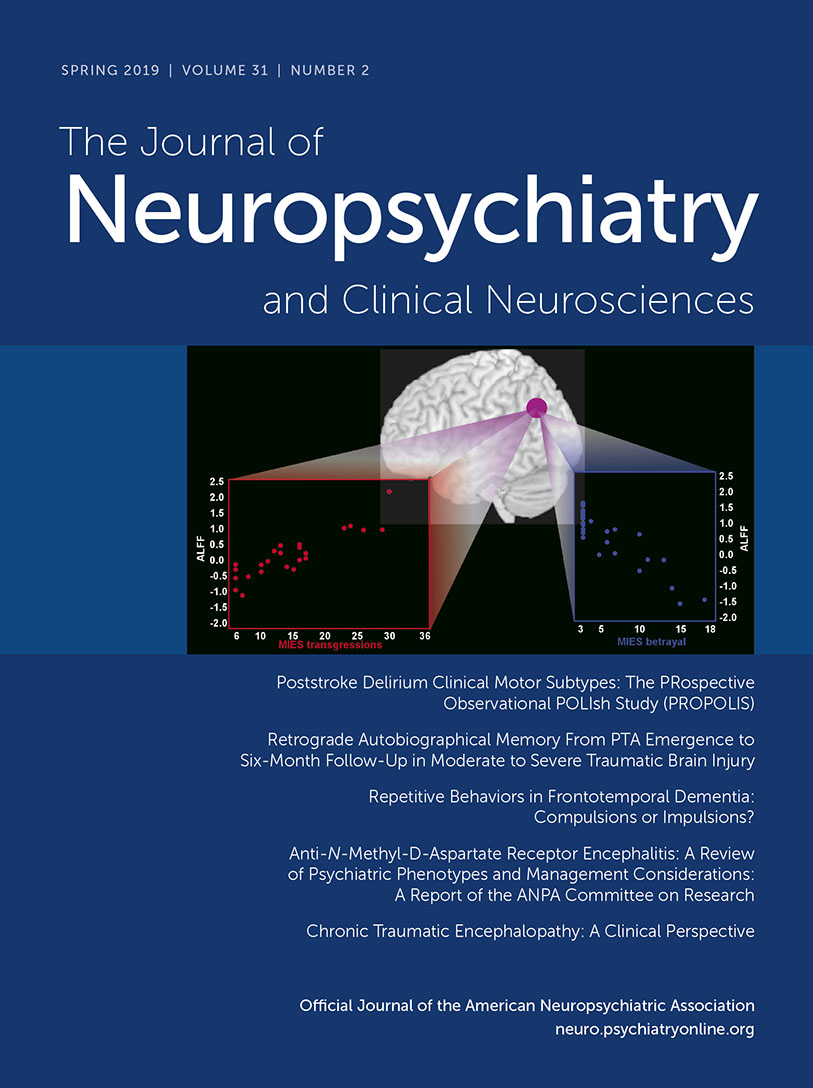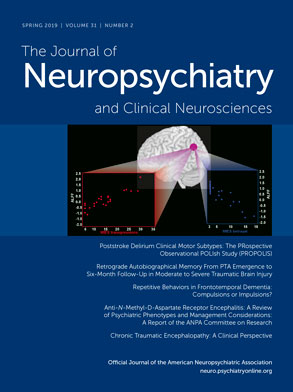Behavioral variant frontotemporal dementia (bvFTD) is one of the most common forms of dementia, with an age at onset ≤65 years.
1,2 Clinically, bvFTD presents with personality changes, particularly apathy or inertia, behavioral disinhibition, loss of sympathy or empathy, hyperorality and dietary changes, and dysexecutive behavior.
1 Additionally, these patients have repetitive behavior ranging from simple repetitive movements to more complex compulsive or ritualistic acts.
3–6 Understanding repetitive behavior in bvFTD could help clarify the treatment for this disruptive manifestation of bvFTD.
Despite their repetitive nature, the stereotyped or compulsive-ritualistic behaviors of bvFTD may be more related to impulsivity and disinhibition than to the mechanisms of compulsions as in obsessive-compulsive disorder (OCD).
7 Patients with compulsions perform semipurposeful, repetitive behaviors in a stereotypical fashion, usually driven by obsessional thinking and anxiety, and they engage in these behaviors in an attempt to reduce this anxiety.
8 In contrast, impulsivity is often opportunistic and driven by an immediate urge to gratify a need or desire rather than by a compulsive need to alleviate distress.
9,10 Whereas compulsive patients have a sustained awareness of their need to act, patients who are impulsive tend to rapidly react to internal or external stimuli without considering the consequences of these reactions. Little research has focused on analyzing whether the repetitive behaviors of bvFTD have characteristics that are more like an impulse disorder, as opposed to manifestation of the OCD spectrum. The purpose of this study was to identify the repetitive behaviors of patients with bvFTD within 3 years from the onset of their disorder, characterize their features as indicative of either compulsive or impulsive behavior, and compare these findings with the reported compulsions of patients with OCD.
Results
The main clinical characteristics of the 93 patients with bvFTD were a mean age at onset of 58.2 years (SD=9.1), mean age at presentation of 61.5 years (SD=9.2), mean education level of 15.1 years (SD=2.2), and a mean MMSE score of 23.1 (SD=7.0). Fifty patients were men, and 43 were women. Additionally, 44 patients (47.3%) had repetitive behaviors on initial presentation, with a total of 59 (63.4%) by 3 years into the disease course (on follow-up assessments if not initially at or about 3 years;
Tables 1 and
2). Among these patients, 55 (59.1%) had behavioral disinhibition (including impulsive behavior) on presentation, with a total of 76 (81.7%) by 3 years into the disease course (
Tables 1 and
3). There were no differences in basic clinical characteristics between those with and without repetitive behaviors and those with and without disinhibited or impulsive behaviors.
Repetitive behaviors in these patients with bvFTD mainly presented as verbal repeating, aberrant motor behaviors such as pacing and tapping, hoarding, and excessive unnecessary trips to the bathroom. Except for hoarding, the pattern and frequency of these behaviors were different from what we usually observe in patients with OCD. The most common were stereotypies of speech, including repetition of their own words or phrases (palilalia), of others’ words or phrases (echolalia), repetitive nonword sounds, or rhyming of words based on sounds (clanging). This was followed by simple repetitive movements, particularly pacing, tapping, or picking. Hoarding or collecting tended to be associated with decreased self-care, the so-called “Diogenes syndrome.”
12 Another common repetitive behavior was multiple and unnecessary trips to the bathroom, often with little need or production. This last repetitive behavior was verified by observation, urological evaluations, or both. The common OCD behaviors of checking, cleaning, counting, and ordering were relatively infrequent in the bvFTD patients, except for hoarding and collecting, which were similarly present in both disorders (
Table 2).
Although incomplete due to lack of documentation or specific mention in some cases, the abstraction tool was able to gather information on most of the items in the 59 bvFTD patients with repetitive behaviors. First, there were no records of any preevent anxiety or distress or of any established obsessional thoughts, independent of expressed immediate need, driving the repetitive behaviors. There were also no verbal reports of postevent relief reported by the patients. Most of the time, the behaviors could be impeded temporarily, but they subsequently recurred. In between repetitive acts, the patients did not express a need to perform their repetitive behaviors and, when queried, lacked insight into even having them. Finally, many of the repetitive acts appeared to be triggered by external factors, such as the presence of others or the sudden need to leave an examination room, or by internal stimuli such as the sensation of the need to void.
The majority of the bvFTD patients also presented with disinhibited or impulsive acts including social inappropriateness. By 3 years into their disease, all the patients with repetitive behaviors had impulsive or disinhibited behaviors; 17 were disinhibited or impulsive without repetitive behaviors. There was a great deal of overlap between the specific behaviors used to meet criteria for behavioral disinhibition and the repetitive behaviors; often they were the same verbal or physical acts, but performed in a repetitive fashion (
Table 3).
Discussion
We identified the most common repetitive behaviors among 59 (63.4%) of 93 patients with bvFTD within 3 years from the onset of symptoms. Their repetitive behaviors did not include many of the characteristics of OCD compulsions, but impulsive or disinhibited behaviors were present in all of these patients. Repeating particular words or catch phrases, pacing, tapping or motor stereotypies, hoarding, and frequent unnecessary trips to the bathroom were common among these patients with bvFTD, whereas typical OCD compulsions of checking, cleaning, counting, and ordering were relatively infrequent. Our findings suggest that the repetitive behaviors of bvFTD are an impulse spectrum disorder from frontostriatal and related regional involvement in the disease.
There were several observations that were more consistent with an impulse-control disorder than with OCD. First, none of the patients with bvFTD reported anxiety, discomfort, obsessional thinking, or an attempt to relieve anxiety associated with their repetitive behaviors. Second, the patients were not obsessed or preoccupied with their behaviors and not clearly focused on them between repetitive acts. Third, other individuals were able to stop or inhibit the patients from manifesting their repetitive acts without causing them overt distress. Fourth, the trigger was often an internal or external stimulus, such as a slight need to void or the sight of an item of interest. The same impulsive mechanism may be the origin of hyperorality, from the sensation of hunger or craving for tobacco or alcohol, which is a criterion for bvFTD, and the increased sexual behavior in some patients.
4,7 Finally, among patients with bvFTD in our study, the repetitive behaviors were associated with a lack of insight or awareness of their behavior or the consequences of their actions. In fact, the patients almost always denied that their repetitive behaviors were a problem.
In contrast, patients with OCD have an awareness of anxiety and distress. They often report being driven by obsessions or recurrent and persistent thoughts that are intrusive and unwanted, and they attempt to ignore, suppress, or neutralize them with compulsions.
8 These compulsions are repetitive, excessive, and often unrealistic behaviors that the individual feels driven to perform in order to reduce anxiety or distress.
8 Common compulsions among patients with OCD are washing, checking, ordering, and hoarding, as well as mental compulsions such as counting.
11,13 These typical compulsive behaviors occur with much less prevalence among patients with bvFTD compared with patients with OCD (
Table 2). Other OCD-related behaviors can occur in bvFTD, including trichotillomania or hair-pulling and excoriation or skin-picking.
7,14 However, with the possible exception of hoarding behavior, our results demonstrate that the common repetitive behaviors of bvFTD are different from those observed in OCD.
The largest overlap between repetitive behaviors in bvFTD and OCD was with hoarding, but this was also distinct in the two disorders. Among patients with bvFTD, hoarding was accompanied with a decline in self-awareness and self-care, leading to a tendency for disordered clutter—a combination referred to as Diogenes syndrome.
3,15 Distinct from OCD-related hoarding syndrome, patients with bvFTD exhibited little interest in the accumulated items once collected, and they allowed others to discard them.
12 Previous reports of hoarding in bvFTD have suggested that the behavior is a disinhibited pathological orientation to environmental items in patients with frontotemporal disorders,
16 similar to utilization and imitation behavior and some cases of pathological stealing.
17,18The repetitive behaviors in bvFTD patients are also somewhat different from traditional impulse-control disorders, where the underlying cause of the problem is the self-control of emotions and behaviors that can be disruptive to others. Patients with bvFTD do not have the well-known impulse-control disorders, such as oppositional defiant disorder, intermittent explosive disorder, and pyromania, but they do have pathological stealing and may manifest punding behavior. In addition, many of the repetitive behaviors of bvFTD are simple purposeless movements, such as tapping. The clinical spectrum of repetitive movements in bvFTD are more like typical motor stereotypies than impulse-control disorders, and complex repetitive behaviors in bvFTD tend to occur in patients who already have these simple motor movements.
5,19Putting this together, patients with bvFTD may have repetitive impulsions, distinct from both OCD and impulse disorders, from involvement of frontal and temporal regions.
4,6 Many of the simple movements or repetitive behaviors may result from an inability to inhibit urges to perform movements, stemming from damage to frontal-striatal circuits.
3 However, the complexity of the repetitive behaviors may relate to the disease extending to the anterior temporal region.
4,6 In a study of 90 patients with FTD spectrum syndromes, more complex, intentional, and time-consuming repetitive behaviors tended to involve the anterior temporal lobe, especially if asymmetry of atrophy was present.
6 Finally, decreased serotonin receptor binding occurs in the frontal and temporal lobes in autopsy-proven FTD, and the cause of repetitive behaviors may be a consequence of serotonergic loss.
4Repetitive behaviors in bvFTD are disruptive and difficult to manage, but a number of medications have been tried, particularly focusing on the serotonergic system. Some of these patients responded to high-dose selective serotonin reuptake inhibitors (SSRIs), such as sertraline or paroxetine
20; however, the improvement was usually small. Specific repetitive behaviors, such as pathological stealing, may not respond to SSRI medications at all.
21 Other medications that have been tried with modest success include the tricyclic clomipramine at daily dosages varying from 20 to 175 mg, starting with a 10-mg dose increased per week.
22 In bvFTD, topiramate may modulate alcohol abuse,
23 and ciproterone has been used for compulsive masturbation.
24 Topiramate along with fluvoxamine has helped with impulsive smoking, overeating, and skin-picking in FTD.
7 In comparison, acetylcholinesterase inhibitors may increase disinhibited or repetitive acts and are generally not indicated.
25 Behavioral and environmental management is also critical, particularly structuring the environment so that patients are safe and cannot manifest a potentially harmful repetitive behavior.
A number of factors may limit the interpretation of our results. First, the data used in this study were gathered through clinical, retrospective review with abstraction questions. In many cases, there was a lack of complete documentation of characteristics of the repetitive behavior. Nevertheless, the clinical intake evaluations were comprehensive enough that the presence of positive characteristics, such as anxiety or obsessions, would likely have been mentioned and recorded. Second, most of the information was provided by a caregiver or family member rather than the patients themselves. Because of the lack of insight and awareness in bvFTD, the patients often did not elaborate or describe their feelings or experiences to the examiner. We could not completely exclude the possibility that, for example, they had anxiety, distress, or obsessions and simply denied or did not report them. In general, this is an inherent consideration in studying patients with bvFTD.

